Martinů
in Paris: A Synthesis of Musical Styles
and Symbols
By
Erik Anthony
Entwistle
II. How Martinů
“Got Rhythm”
Il est vie. Il
est art. Il est ivresse des sons
et des bruits. Il est joie animale
des mouvements souples. Il est mélancolie
des passions. Il est nous d’aujourd’hui.
It is positive
and spontaneous, [with an] almost
primitive touch, …complicated but
not subtle. It coalesces with life
and avoids nothing in which life
is manifest.
With their expression
of similar sentiments, the preceding
two quotes are related, but not in the
way one might expect. In the first,
André Coeuroy, a French musicologist,
critic and friend of Martinů, writes
about the jazz phenomenon in his book
entitled, appropriately enough, Le
Jazz.
In the second quote, the author is Martinů,
but he is not speaking about jazz -
he is discussing the music of Stravinsky.
In
Martinů’s experience the two influences
clearly became intertwined; indeed,
in addition to the ministrations of
Albert Roussel, Martinů’s most
important reckoning upon his arrival
in Paris could be summed up in three
words: jazz and Stravinsky. The influence
exerted by both upon Martinů proved
synergistic and led to an immediate,
and in many ways shocking, stylistic
re-orientation.
Martinů
would no doubt have concurred with Coeuroy’s
observations on jazz, which included
the ironic statement that “en vain
fermera-t-on l’oreille au jazz".
The Czech composer
himself was not reticent on the subject,
pointing out that "the continuous
stream of short jazz notes and the unity
in the chaos of rhythms captures the
impetuousness and nervousness of the
time, and it’s no wonder almost all
the young took this style as their own."
Comparing the influence of jazz to that
of the folk music, Martinů noted:
I often think of
the amazingly pregnant rhythm of
our Slav folk songs, of our Slovak
songs, of their characteristic rhythmical,
instrumental accompaniment, and
it seems to me that it is unnecessary
for us to have recourse to the jazz
band. Nevertheless I cannot deny
the part it plays in the stream
of our life, which dictates all
that it needs for its expression.
It is another question, however,
how this influence should be realized.
Roussel expressed similar
sentiments to those of Martinů
in his own cautious assessment of the
place of jazz in the current musical
milieu:
It seems to me
that the jazz band is incontestably
"musical," which is not
to say that all compositions written
for this instrumentation are musical
in the traditional sense; but one
cannot deny that the music played
by these bands is fascinating and
I, for my part, have been charmed
on more than one occasion by a very
particular sonority or character.
I must admit, however, that despite
the prodigious virtuosity of some
of the instrumentalists, a prolonged
hearing of jazz becomes monotonous
and irritating to me.
Without a doubt,
jazz exercises a very marked influence
on the aesthetic of a certain number
of young composers. Its particular
rhythms and characteristic weak-beat
accents can be recognized in a number
of modern works, as well as the
curious manner of an orchestration
which features a seemingly paradoxical
union of instruments that has for
twenty-five years enlarged and enriched
the field of combined sonorities.
On the other hand I do not believe
that it is the nature of this influence
to modify the musical forms themselves.
An original and
independent jazz music, obeying
its own laws, already exists in
America. I do not see why it could
not develop also in Europe. The
use of popular songs and the invention
of tunes suited to the particular
genius of the race would permit
capable specialists to form a repertoire
that would no doubt transform itself
little by little and whose evolution
would perhaps one day give birth
to a new aesthetic.
It should be kept
in mind that Martinů had already
flirted with the popular idiom while
still in Prague, having several foxtrots
and cabaret songs to his credit before
he settled in Paris. These modest forays
show Martinů’s predisposition to
such materials, but from them
one would not have predicted the decisive
contribution jazz would soon make to
the compositional technique of his earliest
Parisian works.
The pivotal discovery
of Stravinsky’s music has often been
misleadingly described as having a more
lasting influence
than Martinů’s love affair with
jazz. Certainly Martinů made no
secret of his admiration, writing a
series of articles devoted to Stravinsky’s
music for Czech newspapers, journals
and concert programs during his early
Paris years. At once Martinů’s
music also began to show signs
of this aesthetic allegiance, which
in the notorious case of Half-time
won him accusations of blatantly plagiarizing
his Russian counterpart.
Putting aside such
accusations for the moment, what strikes
us in Half-time and other
works of the period is that Martinů’s
new approach to rhythm is remarkably
confident, if still admittedly experimental
and indebted to the innovations of others.
Martinů had at last found a way
to begin to express himself by creating
an “art in line with the problems
of [the day]." If Debussy’s Nocturnes
had once given him encouragement to
pursue another course in rejection of
the Prague musical establishment, in
Paris it was now the Soldier’s Tale,
the Rite of Spring and dances
such as the tango and Charleston that
provided the composer the stimulus he
needed for his newest creative exploits.
Martinů’s
new rhythmic orientation can be observed
in a trio of works written in 1924:
Half-time (Rondo for orchestra)
mentioned above, the Quartet for
clarinet, horn, violoncello and side
drum, and the Concertino for violoncello
and small orchestra. The unusual instrumentation
of the Quartet brings to mind the sound
world of Stravinsky’s Soldier’s Tale,
with Martinů building up musical
textures in collage-like fashion from
short, ostinato-like motives - another
Stravinskian trademark. The following
example, taken from the finale,
shows three contrasting elements treated
simultaneously:

Only the horn (middle
staff) seems interested in complying
with the 3/8 meter by offering a lilting
melody, and this only at first. It soon
takes over the polka-like (anapest)
rhythmic motive heard in the clarinet,
a favorite rhythmic device of the composer.
Meanwhile the cello engages in a different
rhythmic trick, playing groups of three
sixteenth notes across the bar line,
adding to the polyrhythmic effect. In
jazz such
syncopated groupings of three are sometimes
referred to as “secondary ragtime”,
and it is a device that quickly becomes
a mannerism in Martinů’s music,
as was the case with Gershwin’s Rhapsody
in Blue written in the same year.
After handing over the polka
rhythm to the horn, the clarinet takes
up the cello’s secondary ragtime pattern,
but the accents emphasize the fact that
the two patterns are not aligned vertically.
There is a dry, playful quality to the
passage as Martinů objectifies
rhythms into a conglomeration
of clashing ostinati.
If the Quartet seems
is reminiscent in places of The Soldier’s
Tale, a work that also explores
rhythmic patterns from ragtime in a
similar fashion, the orchestral Half-time
takes its cue from Petrushka and
The Rite of Spring. In Half-time
the pagan-inspired primitivism of the
Rite is brought to bear on modern
society and transferred to the soccer
field. Repetitive ostinati are once
again featured, of which the following
one, heard midway through the piece
in the piano part, is an example:

This
percussive style is elsewhere wedded
to the secondary ragtime rhythm hinted
at in the example above. Characteristically,
Martinů seems interested in exploring
the complementary aspects of the two
approaches, jazzing up the essentially
Stravinskian gesture:

The Concertino pits
a stringless ensemble of wind orchestra,
piano, and side drum against that most
romantic of stringed instruments, the
cello - an arrangement reminiscent of
the earlier Quartet but transferred
to an enlarged, concertante setting.
Here the soloist and orchestra frequently
clash with contrasting materials, with
rhythmic aspects intruding on melodic
ones. In this work the ghost of Petrushka
lives on, but he dances the Charleston.
Towards the end of the work the trademark
pattern of parallel triads in the orchestra
(piano reduction) offsets a stepwise
melody in the cello of great simplicity,
resembling a Slavic chant or folk tune.
Underneath it all can be heard the military
fanfare that opened the piece, adding
a third layer to another collage-like
musical texture:

In this work an
additional kind of rhythmic treatment
emerges, one that proves no less characteristic.
Martinů applies a syncopated, dance-like
pattern to his melody and slows the
tempo to at least half of what one would
encounter in the dance hall (note how
the pattern
at high speed resembles a cakewalk if
one begins the pattern on the staccato
eighth note). The “slow syncopation”
of this passage gives it a very special,
sprung quality that Martinů apparently
relishes, judging by how often it is
encountered in future works.
In this example, the espressivo
marking indicates Martinů’s intention,
creating an overarching lyricism despite
the staccato eighth notes followed by
accented, syncopated quarters:

The
year 1926 finds Martinů still composing
in a similar vein in his Trois
danses tchèques
for piano solo. This work is Martinů’s
first explicitly titled “Czech” work
to be written in Paris, and as such
makes an interesting case study for
investigating the role of rhythm with
regard to musical nationalism in Martinů’s
Parisian works. Although published under
the title Trois danses tchèques,
Martinů’s manuscript gives the
title La Polka Tchèque.
Indeed, the Obkročák
(round dance) and Dupák
(stamping dance) that constitute the
first and second dances are both of
the polka type, and the finale is simply
titled "Polka".
Just as Paul Whiteman
and his orchestra
indulged in the habit of ragging ordinary
tunes via added syncopation, Martinů
blends jazz and folk elements in his
Trois danses tchèques.
In
fact Martinů’s jazz-derived
embellishments, combined with other
metrical tricks, come near in places
to disintegrating the national element
entirely. In the first movement (Obkročák),
the meter curiously shifts to 3/4 as
early as measure three. This is no doubt
imperceptible to the listener, and seems
to be of questionable musical significance.
In hindsight, however, it anticipates
the rapid shifts from 2/4 to 3/4 that
occur in bars five through eight. Indeed,
much of the movement strays from 2/4
or adopts opposing rhythmic patterns
within it, undermining the polka’s rhythmic
hegemony. Here
Martinů is probably alluding to
the Czech mateník
or "muddling" dances that
feature alternating duple and triple
meters and are often danced to the steps
of the obkročák.
The polka tune that
begins the piece comfortably inhabits
the world of Smetana, but Stravinsky
is also undeniably present in the harmonically
clashing left-hand ostinato, immediately
establishing the modern character of
the music. Soon a surprise occurs; in
measure four the listener is suddenly
transported from the Slavic folk realm
to a 1920’s Parisian dance hall where
the rhythms of the Charleston can be
heard:


Martinů
had used a similar device in a recently
completed piano cycle entitled Loutky
(Puppets). These short, pedagogically
oriented works depict various characters
from the Italian commedia dell’ arte.
The second piece from Book One is entitled
Nová loutka (The New Puppet)
and the music is subtitled "Shimmy".
Here the polka, as in the obkročák,
is "jazzed up" with a secondary
ragtime pattern:
 Clearly
this new puppet could dance the shimmy
as well as the polka, and in quick succession.
Later in the piece,
in a gesture to his beloved Debussy,
Martinů has his new puppet dance
the cakewalk. It is introduced by jarringly
dissonant, off-the-beat chords, with
the entire passage suggesting a grotesque
cockiness to the new puppet’s dance:
Clearly
this new puppet could dance the shimmy
as well as the polka, and in quick succession.
Later in the piece,
in a gesture to his beloved Debussy,
Martinů has his new puppet dance
the cakewalk. It is introduced by jarringly
dissonant, off-the-beat chords, with
the entire passage suggesting a grotesque
cockiness to the new puppet’s dance:
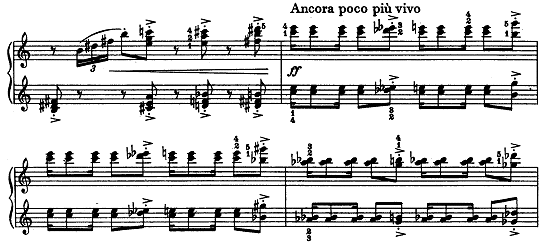
Martinů’s
clever metaphor here is perhaps
obvious but nonetheless important: the
conventional world of the commedia
dell’ arte has been invaded by a
shocking but irresistible new element.
The music has a distinctly ironic aspect
as it brings this comically naïve
world up to date with the shimmy, notorious
for its sexual suggestiveness, and the
cakewalk, a genre that parodied genteel
white dances.
In the Trois danses
tchèques Martinů
adopts a similarly playful but rather
more complex procedure as the obkročák
unfolds. After taking turns in the opening
of the work, the polka and Charleston
elements enter into conflict, each stubbornly
proclaiming dominance over the other.
In the following example the left hand
now has the pattern of three sixteenths
derived from the Charleston’s characteristic
syncopation (again, the so-called secondary
ragtime rhythm), with the right hand
adopting the square polka rhythms. The
highly chromatic harmonic setting and
virtuosic piano writing, coupled with
the emphatic accents and resulting cross
rhythms enhance the feeling of tense
opposition, with each hand seemingly
more concerned with its own course rather
than the simultaneous effect:
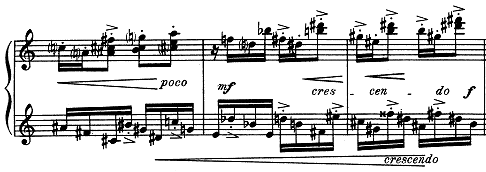
Later in the piece
a truce appears to have been called
as both elements are now combined against
less complicated (if independent) diatonic
progressions, suggesting a comfortable
synthesis between the two. Jazz does
seem to have gained the upper hand however,
dominating in the right hand with its
accents intact:
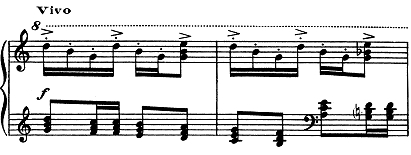
The general approach
observed in the obkročak
can also be found in the
remaining two movements. The second
movement, Dupák, features
more extensive use of opposing meters
reminiscent of the mateník,
to the point of opening in triple rather
than duple meter. Encountered again
are passages reminiscent of ragtime,
as in the following example in which
a three sixteenth-note melodic pattern
is superimposed on eighth notes in duple
meter, giving a secondary ragtime texture
complete with typical accompaniment.
Such passages are not exactly subtle,
and Martinů seems to delight in
their frankly clichéd rhythmic character
while in this case exploring a nonfunctional
progression of broken triads:

The finale continues
the exuberant virtuosity of the first
two dances. In one delightful passage
that underscores
the essential lightness of Martinů’s
overall conception, a particularly infectious
combination occurs, with a Smetanian
polka tune in the right hand and a syncopated,
Charleston-like pattern in the left
hand:

Martinů
continued to favor such juxtapositions
on both the horizontal and vertical
planes in subsequent works. Belonging
to the horizontal type is the following
example from the finale of the Sonata
in D minor for violin and piano (1926),
in which the polka tune is rudely interrupted
by three secondary ragtime patterns,
only to resume right where it left off
in the final measure (and beyond, where
the pattern of interruption is repeated):
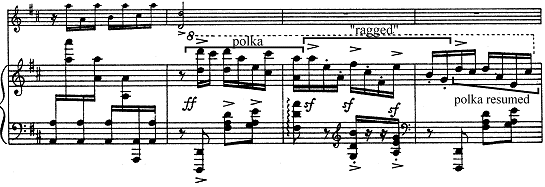
The opening movement
of the String Quartet No. 2 (1925),
one of the first works to gain Martinů
a wide reputation, goes a step further,
introducing secondary ragtime, quick
foxtrot (suggested by dotted rhythms),
and then polka in rapid succession:
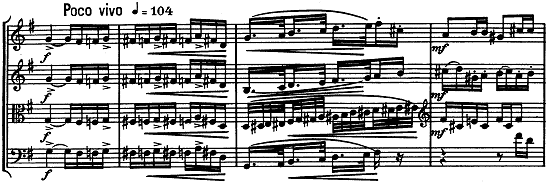
Horizontal and vertical
juxtapositions occur simultaneously
in the following examples. In the first
movement of the Piano Concerto No.1,
the right hand of the soloist alternates
familiarly between polka and secondary
ragtime rhythms, with the left hand
following suit. In the orchestra (reduction
shown), vertical conflict occurs as
both rhythmic types occur simultaneously.
As the piano part is ragged it briefly
comes into rhythmic alignment with the
treble part of the orchestra. In the
bass, there is a further oddity; the
polka rhythms are organized in waltz-like
patterns of three:
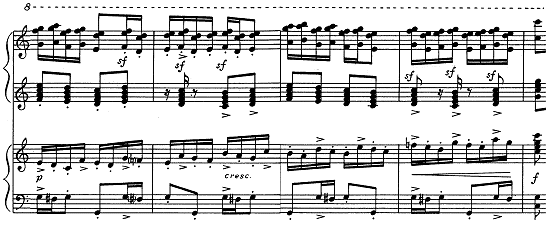
Another example of
waltzing the polka, but without the
addition of jazz syncopations, occurs
in the finale of Quatre mouvements
(1929) for piano solo. As in the
Trois danses tchèques,
the changing meters only add to the
confusion and tend to conceal what is
actually occurring rhythmically. Waltz
alternates with polka, but the switch
is not unequivocal since the polka rhythms
in the right hand are once again arranged
in groups of three:
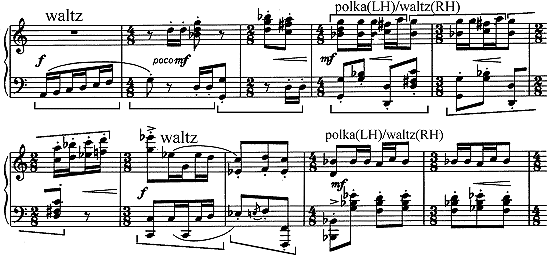
It is clear that several
"Martinů-isms”
emerged from all of this rhythmic experimentation.
These characteristics remain alive and
well to the end of Martinů’s Paris
period and beyond. Perhaps the slow
syncopation seen in the Concertino
for cello (example above) becomes most
emblematic, for it is encountered in
innumerable works. In the example from
the Concertino, the L-L-S-L-S
pattern repeats regularly within common
time measures. However, Martinů
most typically employed uneven patterns
that would subvert the regular meter
or call forth irregular ones.
Several different metrical approaches
for very similar music can be observed
in the following examples, each of which
features a basic pattern L-L-S. In the
first (Improvisation for piano, 1937),
the 5/8 meter reflects the length
of the pattern, but Martinů unaccountably
changes to 4/8 and 6/8 in the following
measures rather than leaving the 5/8
meter intact. The harmonic structure
is, by contrast, extremely simplified.
In the second example (Sinfonietta
Giocosa for piano and orchestra,
1940), the meter is unchanged, leaving
the pattern to spill over the bar lines,
with harmonically unstable music:


Sometimes
Martinů employs an expanded pattern
of L-L-L-S with similar results, as
the following example in duple meter
from the finale of the Violin
Concerto No.1 (1933) demonstrates. Here,
harmonies clash abrasively in a bitonal
setting:

Martinů
ultimately preferred this simpler metrical
approach, letting the syncopated patterns
fall where they may. A final example
of a L-L-S pattern, within triple
meter this time, shows this approach
as part of a disarmingly simple, stylized
folk setting entirely characteristic
of the composer, featuring thirds and
sixths in a tonal harmonic structure.
It is taken from the suite to his opera,
Divadlo za branou (Theater Beyond
the Gate, 1936):
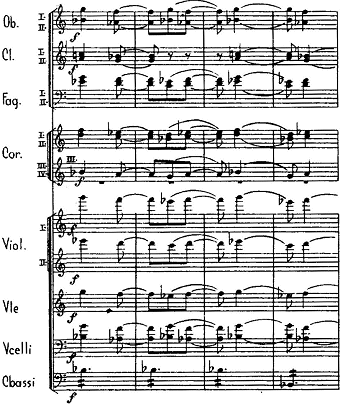
Another passage that
displays similar characteristics is
the opening orchestral ritornello from
the Concertino for piano and orchestra
(1938). Here, simultaneous two-note
oscillations in the violins and violas
are realized in accented patterns that
disregard the bar lines. The cellos
and basses have their own distinctive,
but rhythmically less active accompanimental
pattern, which also reflects the harmonic
rhythm (shifting ominously back and
forth from minor tonic to vii7). These
repetitive oscillations between two
notes reflect the minimalist style characterized
by the composer’s use of short rhythmic
and melodic cells. As elsewhere, Stravinsky’s
use of ostinati is a palpable influence,
but there is also an unmistakable connection
to the hypnotic world of impressionism:

Another
mannerism that unmistakably evolved
from the early Paris works is Martinů’s
obsessive use of the secondary ragtime
pattern. It sometimes functions as an
explicit reference to ragtime
or the dance hall, and often with humorous
overtones. In the following example
from the first of Seven arabesques
for violin (or violoncello) and piano,
Martinů rags an octatonic scale.
It is quite possible that he is parodying
or even mocking Stravinsky, for
elsewhere in the piece there are explicit
references to The Rite of Spring.
Here, the ostinati in the piano part
provide the underpinning to the ascending
octatonic scale in the violin in secondary
ragtime rhythm, producing a lively combination:

If
this is typical of the earlier Paris
years, later Martinů tends to employ
the pattern for its own sake in pieces
that otherwise have little to do with
jazz. Indeed, this tendency to absorb
the pattern into a general neo-Baroque
motorism proved increasingly
salient. This is not surprising, for
as time passed in Paris the dance craze
began to fade as the novelty wore off.
True, as late as 1936 an explicitly
"jazzy" use of this pattern
in a piano solo from the suite from
the opera, Divadlo za branou (Theater
Beyond the Gate) is encountered:

This
is, however, an exception, with Martinů
taking advantage of a return to the
stock characters of the commedia
dell’ arte featured in the opera
in order to recall the humorous music
of the "New Puppet" discussed
earlier.
Emblematic of the more
objective
approach are the following four examples,
showing very different ways in which
Martinů employs the secondary ragtime
pattern. In La Fantaisie
for two pianos, it combines very eccentrically
in rapid tempo with an augmentation
of itself in the second piano part.
The two pianos do not correspond rhythmically
at all, but the overall effect is of
the first piano rhythmically filling
in the spaces of the second:
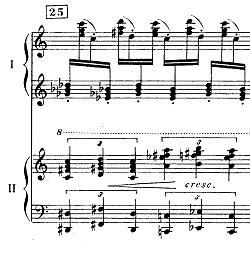
In the finale of the
piano cycle Les Ritournelles (1932),
there is a certainly a hint of jazz
in the following very agitated passage,
but the overriding impression is one
of constant motoric rhythm, without
explicitly invoking the dance hall:

From the same year
comes the following example from the
first of five Esquisses de danses.
Here is the by now familiar juxtaposition
of polka and jazz rhythmic patterns,
but the syncopation is less explicitly
"jazzy", if still clearly
derived from popular dance. The overall
effect is subtler, with the texture
pared down and an implied harmony limited
to tonic and dominant:

Characteristic of later
works, where jazz references become
further sublimated, is the following
excerpt from the finale of the Concertino
for piano and orchestra (1938). The
pattern, treated pentatonically, appears
in the solo part almost as a matter
of fact and without accentuation, a
vestige of its former rhythmically pointed
self:

In
addition to jazz, lasting rhythmic influences
can also not surprisingly be detected
from Stravinsky, particularly given
Martinů’s fondness for ostinati.
Another example from La Fantaisie
for two pianos features a passage reminiscent
of Half-time, and by extension,
Stravinsky. Here the resulting sound,
with major/minor clashes a minor second
apart, is deliberately dissonant and
"primitive" in sound:
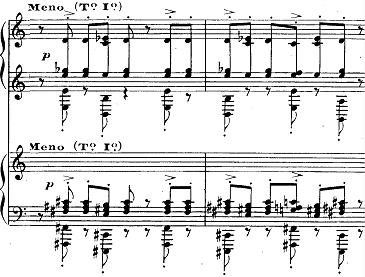
In the previous example
the short "cellule",
according to Martinů’s own terminology,
is immediately expanded. In both cases
the pattern returns to the original
pitch, with only neighboring pitches
used to create a very compact musical
idea. Martinu referred to this as the
“geometric” approach - his tendency
to use a limited number of pitches,
creating a short, self-contained musical
unit, often circling back to the same
opening pitch, and featuring repetition
of notes. Such "cellules"
are often announced at the beginning
of a work and then developed with other
rhythmic ideas. It is worth citing several
examples, chronologically for convenience,
in order to observe their musical similarities
and consistently compact character (notwithstanding
an often attention-getting long note
at the beginning):
Quartet for clarinet,
horn, cello and side drum (1924): III

String Quartet No.3
(1929): I

String Quartet with
Orchestra (1931): I

Sinfonia Concertante
for two orchestras (1932): I

Serenade No. 3 (1932):
I

Serenade No. 4 (1932):
I

Concert pour trio
(1933): I

Inventions (1934):
I

Concerto for Flute,
Violin and Orchestra: I (1936)

Tre Ricercari (1937):
I

Concertino for piano
and orchestra (1937): III

It is noteworthy that
Martinů
often links separate movements of a
larger work by using such cellules cyclically.
As might be expected, there is great
variety in his treatment and realization
of such unifying gestures, and the following
examples show several different approaches.
Martinů’s
Concertino for piano trio and string
orchestra (1933) shows the composer’s
penchant for building motivic relationships
among different movements of a work
as a binding gesture. Interestingly,
he accomplishes this while maintaining
a very traditional four-movement
structure (fast-scherzo-slow-fast),
each having the expected varied characters.
This neo-baroque work is loosely modeled
after the seventeenth-century concerto
grosso, with the violin, cello and
piano forming the concertino
and often featured independently, and
the strings (sometimes with support
of the piano trio) functioning as the
ripieno.
The Concertino features
an identical rhythmic motive in all
four movements. The five-note rhythmic
motive cited here (S-S-S-S-L) constitutes
one of many inter-related rhythmic ideas
appearing throughout the piece. In the
opening Allegro (con brio), the
motive is heard in the ripieno
just before the initial entrance of
the concertino:
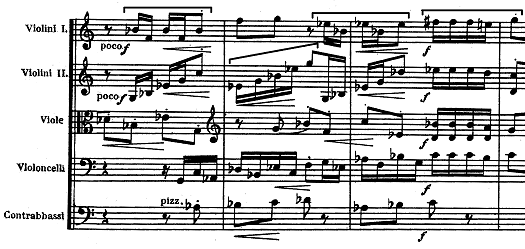
The importance of the
motive to the entire piece starts to
become clear with the opening measures
of the second movement, which functions
as a scherzo. Here, the motive is now
expressed in thirty-second notes:
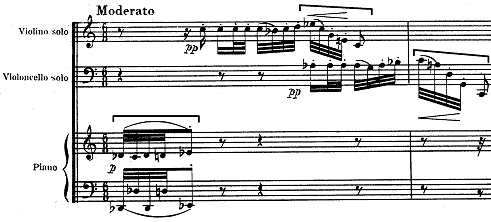
In the proceeding Adagio,
Martinů creates running patterns
of thirty-second notes in the strings,
as if the motive has been expanded indefinitely
from the patterns heard in the scherzo.
The following passage, which culminates
in a statement of the motive, is heard
at the movement’s close, just
before a final F major chord on the
piano:

In the finale (Allegro),
the opening violin solo features the
motive in measure two, expressed once
again in eighth notes. It is preceded
by a shortened version of itself (S-S-L)
and followed by three increasingly long
extensions. The implied harmony of the
violin’s unaccompanied solo, marked
by third relationships until the final
V-I cadence, is also typically free
in approach:


In the following ripieno
the motive is once again prominently
featured, again expressed in eighth
notes:

The Intermezzo (1937)
for violin and piano shows a similar
approach to that of the Concertino,
but in this case it is the motive’s
melodic profile that assumes importance,
(a melodic "cellule", so to
speak). In this cycle of four pieces,
the first, second and fourth movements
begin with closely related melodic shapes
based on a five-note melodic cellule.
The first and fourth pieces are in major,
and the second is in minor. In the fourth
movement the rhythm has been altered,
but this hardly detracts from the easy
recognition of the same melodic profile:
(first movement)

(second movement)

(fourth movement)

In an interesting deviation,
the third movement, marked Andante,
avoids a statement of the motive at
the outset and later only hints at it
with similar melodic fragments, as the
following examples show:


This is an example
of Martinů’s playfulness; after
the first two movements, an attentive
listener would be thwarted in an effort
to find an obvious statement of the
motive in the slow movement, only to
have it return prominently once again
in the finale. Form also plays
a role here - the faster movements are
all cast in simple ABA form, while the
Andante is through-composed and
hence very different structurally from
its neighbors. Thus, the presence of
only vague references to the motive
arguably reflects this formal difference
as well.
Another work written
in the same year, the Duo concertant
for two violins and orchestra, shows
yet another approach. Here, a short
rhythmic cell heralds the beginning
of each of the three movements. The
energetic three-note motive serves as
a similar departure point for very different
musics. In the motoric outer movements,
the motive assumes structural importance
and is quite prominent, whereas it only
appears symbolically in the slow movement.
Also note the "secondary ragtime"
counterpoint in the viola part of the
third movement,
further evidence of Martinů continuing
to favor such patterns in works not
explicitly related to jazz. Here, as
in some of the works from the 1920’s
discussed earlier, the pattern provides
a refreshing counter-rhythm to the ever-present
polka element so often
favored by Martinů, especially
in his finales:
Poco Allegro

Adagio
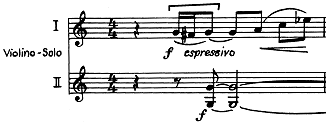
Allegro
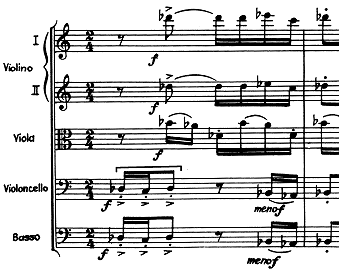
Other
characteristic uses of cells illuminate
important aspects of Martinů’s
art, revealing an individuality that
transcends the apparent influences of
jazz and Stravinsky.
At times Martinů employs a cell
at the beginning of a work, only to
have it blossom later into a full-fledged
tune. A perfect example of this technique
can be seen in the Violin Sonata No.1
(1929), where the opening motive
is shamelessly borrowed from Gershwin’s
Rhapsody in Blue:

Later in the movement
Martinů parodies Ravel’s similar
use of the same idea in his violin sonata,
as the following comparison shows:
(Ravel, "Blues"
movement)

(Martinů, first
movement)


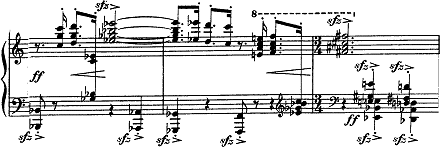
Only
later in Martinů’s first
movement, however, is the entire Gershwin
motto quoted, rhythmically altered.
In the excerpt below, a strange modulation
occurs near the beginning of the tune
when it finally emerges, with a half-step
creep upward from B to C leading to
the Largamente. Then the remainder
of the tune is ragged and extended in
what constitutes, not coincidentally,
the climax of this movement. Here is
Gershwin’s
original, followed by Martinů’s
version:
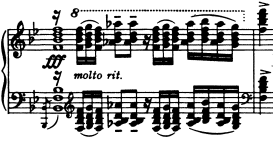

A
further example of building long melodies
from a short cell exists in the finale
of the Divertimento for piano (left
hand) and chamber orchestra (1926),
which finds Martinů at his most
humorous. Here the composer experimented
with completely unrelated orchestral
and solo parts. The orchestra begins
with a statement of the main theme in
the strings and then in the winds, and
the melody begins to develop immediately
as initial statements are expanded in
repetition. Here is the passage in the
woodwinds:
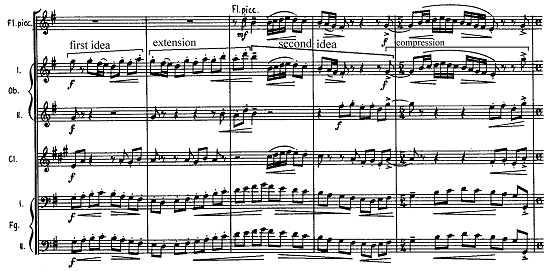
The subsequent left-hand
solo part consists almost entirely of
triplets, with the short cellule clearly
seen in the first bar of the piano’s
entrance. The main idea is mock-heroic,
like a brief fanfare, and offers a totally
different characterization from the
bubbly orchestral dance:

The orchestra almost
entirely avoids this pattern, save for
a few accompanimental gestures that
follow the piano part, and the piano
part likewise ignores the orchestra,
endlessly repeating the triplet figuration.
Other ideas appear as melodic extensions
based on the triplet cellule. With such
a great deal of repetition, this opening
gesture, initially not terribly promising,
becomes ridiculously banal as it is
squeezed dry in various harmonic permutations.
Finally, in the cadenza, a surging,
unabashedly romantic melody with bel
canto-style leaps emerges from the
triplets, only to be cut off by a dissonant
staccato version of the original
motive just as the music reaches a glowing
Wagnerian apotheosis. This is Martinů’s
humor at its most engaging:


In
addition to working with single cells
and their permutations, Martinů
is also fond of building polyrhythmic
structures from various discreet patterns.
In such instances the composer
uses the experiments and discoveries
of the early twenties as ingredients
in very characteristic rhythmic formulations.
The following passage from the sixth
of Seven arabesques
for violin and piano is one example
of Martinů’s sophisticated approach.
The composer seems particularly intrigued
here by combinations of odd numbers,
particularly three and five. The three-note
descending broken triads are stated
five times within three bars. The pattern
repeats within changes of harmony (in
this case a delightfully
clear I-IV-I-V-I in G major), and the
harmonic rhythm is based on three bars
(after the opening five-bar establishment
of the tonic). Another play with five
comes from Martinů’s use of the
pentatonic scale in the tune itself,
which is very strongly
reminiscent of Dvořák. The three-note
motive is repeated and then expanded
into related seven- and nine-note figures,
separated by rests, that overlap the
harmonic changes. In the fourth measure
of the excerpt, the pattern reverts
back to groups of five only when
the solo violin changes its pattern
to go against the meter. Symmetry occurs
between the seven- and nine-note fragments
(7,9,9,7) and the entire, self-contained
passage is fifteen (5x3) bars long:
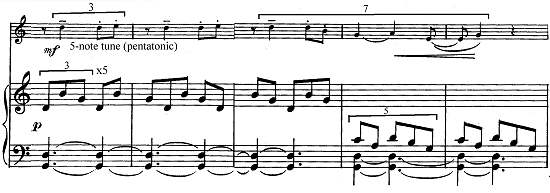

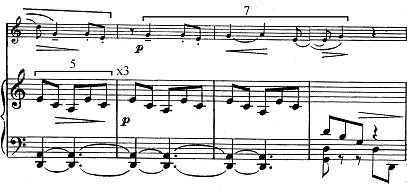
A second example of
playing with threes and fives can be
observed in the Field Mass (1939).
In the piano part, the right hand’s
pentatonic, five-note pattern is out
of sync with the repetitive 3/4 pattern
in the left hand, which is an augmentation
of the right hand’s first three notes.
When the meter shifts to 4/4, both patterns
continue unchanged. The metric shift
is not evident to the listener; though
other instruments enter at this point,
their patterns are too flexible to help
to establish the switch to 4/4. As with
the previous example from the Arabesques,
there is a playful quality to these
combinations:


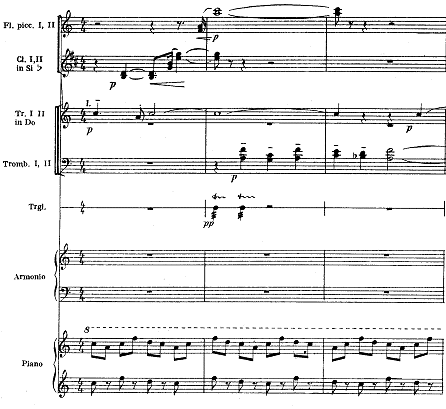
Such metric ambiguity
is a hallmark of Martinů’s fluid
approach to rhythm. In the fourth of
five Esquisses de danses
(1932), as another example, the 3/4
meter and the Tempo di valse
designation promise very familiar rhythmic
territory. But the player (again, not
the listener) becomes immediately aware
that all is not as it should be. The
waltz melody is grouped in eighth, not
quarter notes, and furthermore the groupings
do not even correspond to the bar lines.
When quarter-note motion is finally
introduced in measure three, the result
is a hemiola, as if the waltz has briefly
paused. Measure four resumes the waltz,
but this new phrase is compressed now
that the listener is in on the game,
with only one bar of music necessary
to reestablish the eighth-note motion
before the hemiola returns:

After
Martinů plays rhythmic variations
on this theme during the rest of the
very brief A section, similar ambiguity
continues to be played out in the middle
section. In the following measures the
question arises as to whether three-beat
groupings should be heard twice in each
bar or only once:

As
the section unfolds, subsequent musical
groupings demonstrate that Martinů
indeed has both possibilities in mind
and enjoys playing with the shifting
from one to the next in a rhythmic bait
and switch characteristic of the Czech
furiant. In the following excerpt,
the crescendi reinforce the clear pattern
of two triple groupings within the bar:

Later, however, the
rhythm definitely shifts to three in
a bar, creating a sense of broadening
as the music approaches a climax:

The section culminates
with a cadenza featuring groupings of
three sixteenth-notes, an ultimate diminution
of the groupings of three. At this point
of course the waltz has completely disintegrated
(although it is about to return with
the recapitulation of section A):
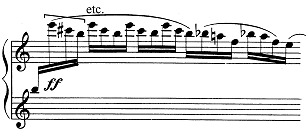
By
way of summarizing Martinů’s approach
to rhythm it is interesting to note
the observations of Czech conductor
Václav Neumann, who recorded the first
complete cycle of Martinů’s symphonies
in the 1970s: “Martinů’s love of
syncopation is a highly special feature
of his music; he is incapable of expressing
any musical ideas in standardized values--he
consistently transforms it into syncopated
shape, shifts the accent to the unaccented
beat.” Complementing
Neumann’s comments are those of the
Russian composer Nikolai Lopatnikoff,
a contemporary of Martinů:
Slavic
characteristics, barely discernible
in Tcherepnine, are much more marked
in Bohuslav Martinů. Living
in Paris, he may be called the most
promising musician of the younger
generation. The richness and strength
of his inspiration, his overflowing
temperament, which at times threatens
to disregard form, reveal him as
a most forceful creative power.
Like Tcherepnine, Martinů is
a supreme master of
rhythm though of a different type.
If Tcherepnine, by his method of
breaking up line, may be designated
as typical of linear rhythmic composition,
Martinů, with his more personal,
compact rhythm--often suggesting
a dance style--may be called a master
of vertical rhythm.
It
is clear that Martinů’s new approach
to rhythm in Paris represented a synthesis
of diverse source materials enthusiastically
adopted by the composer. Stravinsky,
the jazz band, and Czech folk dances
all contributed substantially to Martinů’s
rhythmic palette, with some characteristic
figures appearing with enough frequency
to the point of mannerism. If Martinů
noted in 1941 that “The music of Czechoslovakia
is rhythm - strong, vital rhythm,”
the composer nonetheless did not hesitate
to experiment with a wealth of rhythmic
materials from other sources as well.
As in other aspects of his work, Martinů
strived in the rhythmic component to
create fresh and interesting combinations
and juxtapositions. His all-embracing
attitude paradoxically
yielded the very identifiable rhythmic
traits that characterize his mature
works. This essential component of Martinů’s
music remains an important factor in
the next chapter, which examines the
significance of folk melodies, real
and stylized, to the composer’s
oeuvre.
Introduction
I.
A New Beginning: Life In Paris
II.
How Martinů "Got Rhythm"
III.
Of Folk Tunes, Pastorals, and the Masses
IV.
Dvakrát Svatý Václave
(St. Wenceslas, Twice)
V.
An Aspect of Minor/Major Significance
VI.
Fin de séjour: Julietta
and Musical Symbolism
VII.Conclusion:
Martinů’s Parisian Legacy

